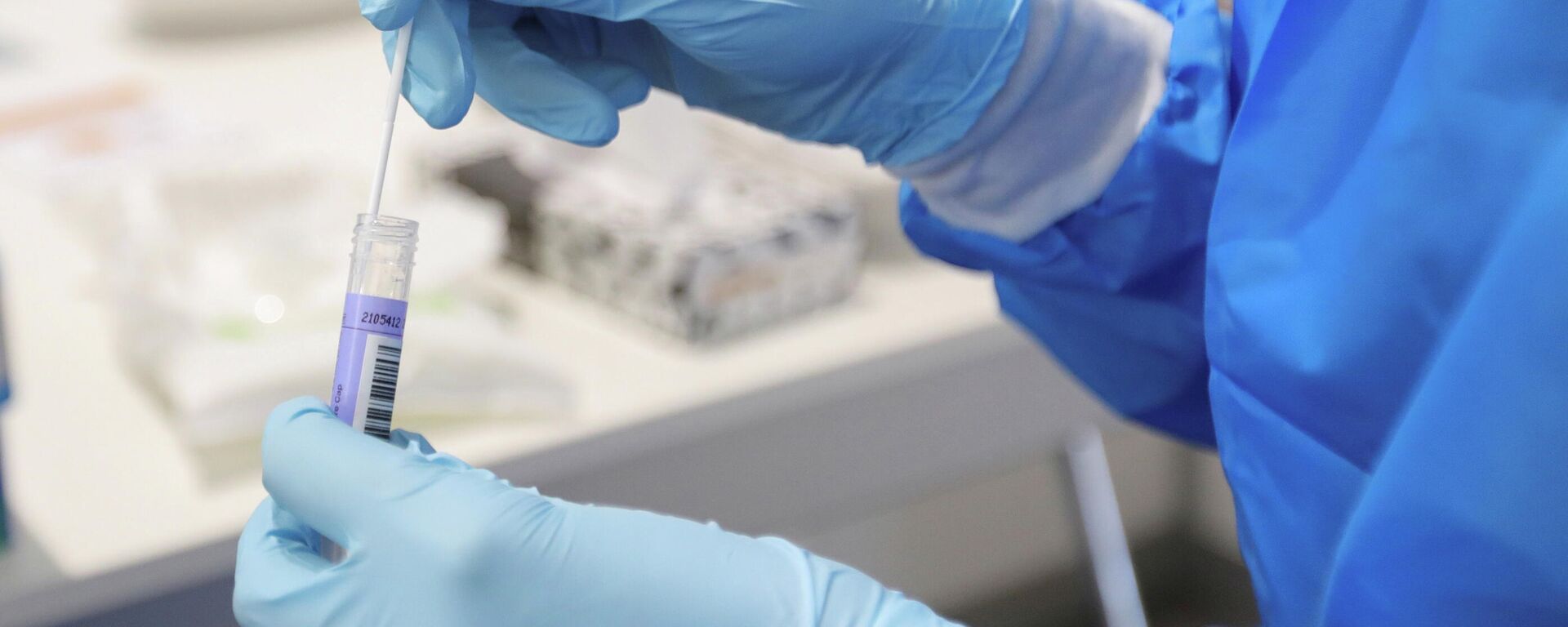https://sputnikglobe.com/20211128/the-omicron-strain-what-is-known-about-new-covid-19-variant-of-concern-1091087266.html
The Omicron Strain: What is Known About New COVID-19 'Variant of Concern'
The Omicron Strain: What is Known About New COVID-19 'Variant of Concern'
Sputnik International
The newly-discovered coronavirus strain has sparked alarm across the world, with many countries imposing travel bans on the southern African nations where it... 28.11.2021, Sputnik International
2021-11-28T14:51+0000
2021-11-28T14:51+0000
2022-11-10T12:53+0000
coronavirus
covid-19
omicron covid strain
pandemic
delta variant of covid-19
south africa
https://cdn1.img.sputnikglobe.com/img/07e5/0b/1c/1091084015_0:0:3391:1907_1920x0_80_0_0_172cd7cf55ea6d6057841a6828e0c650.jpg
But what is known so far about the latest "scariant" — and is the worldwide panic over it justified?WHO Are You?The World Health Organisation (WHO) this week designated the new variant, technically classified as B.1.1.529, with the Greek letter Omicron, after it was reported in South Africa. The UN body immediately added Omicron to its list of Variants of Concern (VOCs).The WHO stressed that the variant shows a large number of mutations (32) compared to earlier strains of COVID-19, and the number cases has increased rapidly in South Africa in the last few weeks.The new variant appears to have quickly displaced the previously-dominant Delta strain in South Africa, far faster than Delta supplanted the Beta strain, lending credence to the belief that it is far more transmissible. What is not yet known is whether Omicron's reported dozens of mutations make it immune to existing antibodies generated by vaccines or natural infection with other variants — in other words whether it is capable of causing so-called "breakthrough" infections.Global SpreadDespite the swift imposition of travel bans on the southern African region, the horse may already have bolted on containing the Omicron variant.Three people in Israel have tested positive, one after returning from Malawi and two coming from Madagascar. One case in Hong Kong had apparently travelled from South Africa, and one in Belgium was found in a person just arrived from Egypt. Two Australians with the variant travelled from South Africa via Qatar in the Middle East.Apart from Belgium, European outbreaks include 13 cases in the Netherlands — out of 61 who tested positive for COVID-19 on two flights from South Africa — three in the UK and two in Germany. Italy, Denmark and the Czech Republic also have cases. In America, the federal Centres for Disease Control and Prevention (CDC) announced that no Omicron cases had been registered in the country.Anthony Fauci, the top US infectious disease official, urged Americans to brace for the spread of the new strain, saying that 32 mutations in the virus suggest that it is more transmittable.SymptomsThe Omicron strain is only associated with mild illness so far, giving hope that it will not lead to a new spike in deaths.South African Medical Association (SAMA) chairwoman Angelique Coetzee told the BBC's Andrew Marr that the variant causes "extremely mild" illness and nobody had yet been admitted to hospital with it.She described how she first encountered the new variant on 18 November, describing its "unusual symptoms" in a male patient about 30 years old.Coetzee also said the spread of Omicron could be masked by the more virulent Delta variant, explaining that it was only spotted in South Africa thanks to a lull in infections.Multiple MutationsThe Italian research institute Bambino Gesu released the first image of the new variant's spike protein, highlighting the number and degree of mutations in various regions.The surface structures give coronavirus its distinctive shape and name from the word crown. Their function is to lock the viral particle on to specific "receptor" proteins in the membranes of host cells, then fuse the particle with the cell to allow its RNA genome to enter and begin replication. But US virologist Angela Rasmussen cautioned against alarmism, saying more mutations do not necessarily make a variant more dangerous.
https://sputnikglobe.com/20211128/south-africa-has-fewer-than-100-omicron-cases-1091084438.html
south africa
Sputnik International
feedback@sputniknews.com
+74956456601
MIA „Rosiya Segodnya“
2021
James Tweedie
https://cdn1.img.sputnikglobe.com/img/07e4/08/1c/1080307270_0:3:397:400_100x100_80_0_0_7777393b9b18802f2e3c5eaa9cbcc612.png
James Tweedie
https://cdn1.img.sputnikglobe.com/img/07e4/08/1c/1080307270_0:3:397:400_100x100_80_0_0_7777393b9b18802f2e3c5eaa9cbcc612.png
News
en_EN
Sputnik International
feedback@sputniknews.com
+74956456601
MIA „Rosiya Segodnya“
Sputnik International
feedback@sputniknews.com
+74956456601
MIA „Rosiya Segodnya“
James Tweedie
https://cdn1.img.sputnikglobe.com/img/07e4/08/1c/1080307270_0:3:397:400_100x100_80_0_0_7777393b9b18802f2e3c5eaa9cbcc612.png
coronavirus, covid-19, pandemic, delta variant of covid-19, south africa
coronavirus, covid-19, pandemic, delta variant of covid-19, south africa
The Omicron Strain: What is Known About New COVID-19 'Variant of Concern'
14:51 GMT 28.11.2021 (Updated: 12:53 GMT 10.11.2022) The newly-discovered coronavirus strain has sparked alarm across the world, with many countries imposing travel bans on the southern African nations where it was first identified — or closing their borders altogether.
But what is known so far about the latest "scariant" — and is the
worldwide panic over it justified?
The
World Health Organisation (WHO) this week designated the new variant, technically classified as B.1.1.529, with the Greek letter Omicron, after it was reported in South Africa. The UN body immediately added Omicron to its list of
Variants of Concern (VOCs).
The
WHO stressed that the variant shows a large number of mutations (32) compared to earlier strains of COVID-19, and the number cases has increased rapidly in South Africa in the last few weeks.
The new variant appears to have quickly displaced the previously-dominant Delta strain in South Africa, far faster than Delta supplanted the Beta strain, lending credence to the belief that it is far more transmissible.
"Preliminary evidence suggests an increased risk of reinfection with this variant, as compared to other VOCs", the WHO says, indicating those who have recovered from other variants could still catch the new one — although this is not yet certain.
What is not yet known is whether Omicron's reported dozens of mutations make it immune to existing antibodies generated by vaccines or natural infection with other variants — in other words whether it is capable of causing so-called "breakthrough" infections.
Despite the swift imposition of travel bans on the southern African region, the horse may already have bolted on containing the Omicron variant.
The first known case was detected in Botswana, north of South Africa, on 9 November. Some 100 cases are so far known in South Africa.
Three people in Israel have tested positive, one after returning from Malawi and two coming from Madagascar.
One case in Hong Kong had apparently travelled from South Africa, and one in Belgium was found in a person just arrived from Egypt. Two Australians with the variant travelled from South Africa via Qatar in the Middle East.
Apart from Belgium, European outbreaks include
13 cases in the Netherlands — out of 61 who tested positive for COVID-19 on two flights from South Africa — three in the UK and two in Germany. Italy, Denmark and the Czech Republic also have cases.
In America, the federal Centres for Disease Control and Prevention (CDC) announced that no Omicron cases had been registered in the country.
Anthony Fauci, the top US infectious disease official, urged Americans to brace for the spread of the new strain, saying that 32 mutations in the virus suggest that it is more transmittable.
"The profile of the mutations strongly suggest that it's going to have an advantage in transmissibility and that it might evade immune protection that you would get, for example, from the monoclonal antibody or from the convalescent serum after a person's been infected and possibly even against some of the vaccine-induced antibodies",
Fauci said in an interview with
NBC.
The Omicron strain is only associated with mild illness so far, giving hope that it will not lead to a new spike in deaths.
South African Medical Association (SAMA) chairwoman Angelique Coetzee told the BBC's Andrew Marr that the variant causes "extremely mild" illness and nobody had yet been admitted to hospital with it.
She described how she first encountered the new variant on 18 November, describing its "unusual symptoms" in a male patient about 30 years old.
The patient described feeling "extremely tired for the past two days" with "body aches and pains with a bit of a headache", and complaining of "not really a sore throat, more a scratchy type of description" and "no cough and no loss of smell and taste".
Coetzee also said the spread of Omicron could be masked by the more virulent Delta variant, explaining that it was only spotted in South Africa thanks to a lull in infections.

28 November 2021, 10:32 GMT
The Italian research institute Bambino Gesu released the first image of the new variant's spike protein, highlighting the number and degree of mutations in various regions.
The surface structures give coronavirus its distinctive shape and name from the word crown. Their function is to lock the viral particle on to specific "receptor" proteins in the membranes of host cells, then fuse the particle with the cell to allow its RNA genome to enter and begin replication.
But US virologist Angela Rasmussen cautioned against alarmism, saying more mutations do not necessarily make a variant more dangerous.






